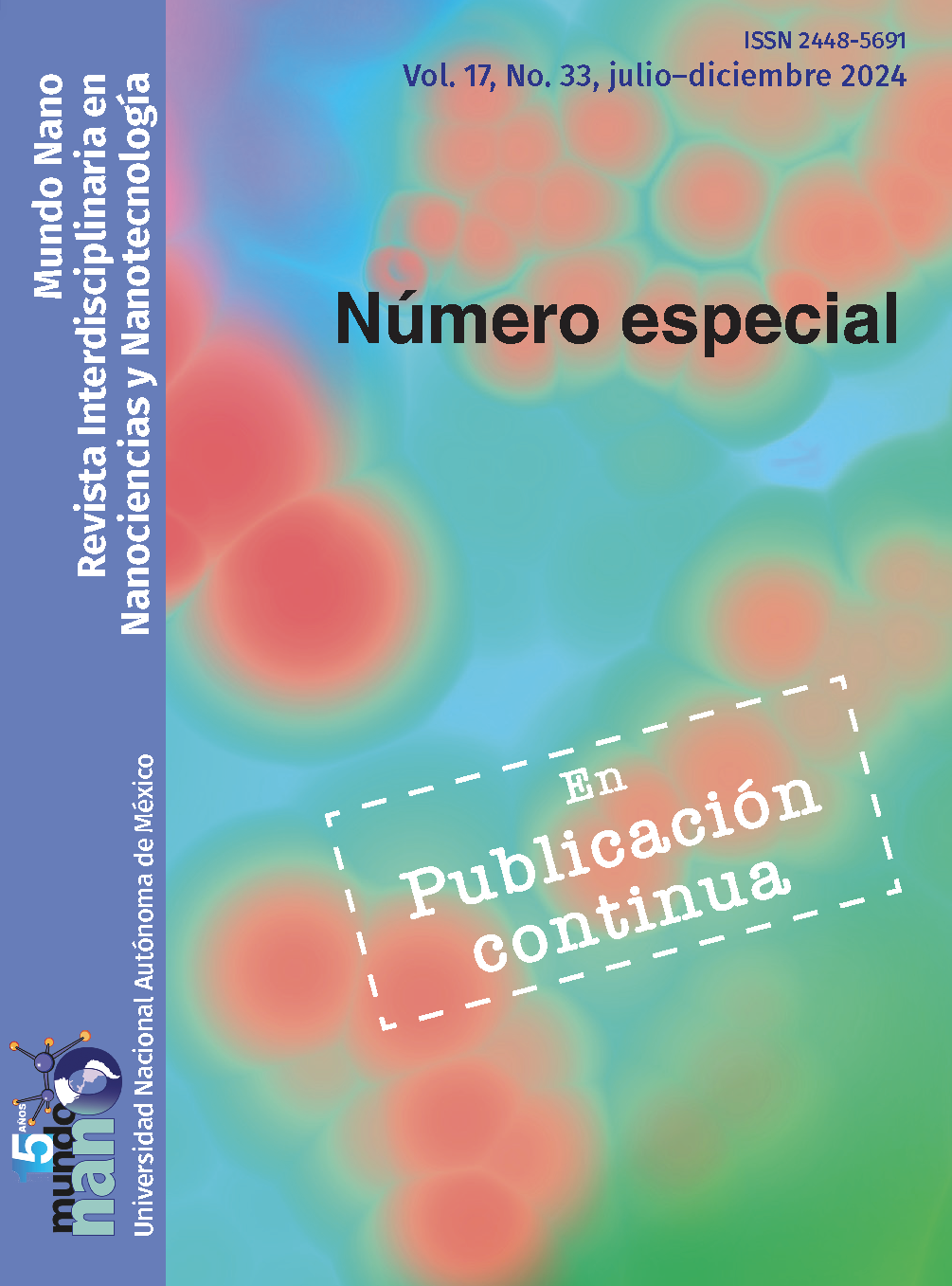Catalytic nanomedicine for chronic wounds in diabetic patients: physiology, pathophysiology, and a success story
Contenido principal del artículo
Resumen
Las heridas crónicas, sobre todo en pacientes diabéticos, afectan gravemente a la calidad de vida. La nanomedicina catalítica ofrece esperanza diseñando bionanocatalizadores, nanoestructuras que dañan selectivamente los ácidos nucleicos. Estas nanoestructuras destacan en desinfección, dañando microorganismos y preservando al mismo tiempo el tejido sano. Se han utilizado para la cicatrización de heridas crónicas, y este estudio explora sus mecanismos y su potencial en la regeneración de tejidos. El artículo subraya su importancia en la desinfección de amplio espectro, incluso contra las biopelículas. Aporta contexto comparando la regulación de la glucosa en estados sanos y diabéticos, centrándose en la patología del pie diabético. Por último, destaca un caso de éxito de herida crónica diabética tratada con nanomedicina catalítica para demostrar su eficacia en la promoción de la cicatrización de heridas.
Descargas
Detalles del artículo

Mundo Nano. Revista Interdisciplinaria en Nanociencias y Nanotecnología, editada por la Universidad Nacional Autónoma de México, se distribuye bajo una Licencia Creative Commons Atribución-NoComercial 4.0 Internacional.
Basada en una obra en http://www.mundonano.unam.mx.
Citas
Banday, Mujeeb Z., Aga S. Sameer and Saniya Nissar. (2020). Pathophysiology of diabetes: an overview. Avicenna Journal of Medicine, 10(04): 174-88. https://doi.org/10.4103/ajm.ajm_53_20. DOI: https://doi.org/10.4103/ajm.ajm_53_20
Bandyk, Dennis F. (2018). The diabetic foot: pathophysiology, evaluation, and treatment. Seminars in Vascular Surgery, 31(2-4): 43-48. https://doi.org/10.1053/j.semvascsurg.2019.02.001. DOI: https://doi.org/10.1053/j.semvascsurg.2019.02.001
Bimstein, E., D. Zangen, W. Abedrahim, and J. Katz. (2019). Type 1 diabetes mellitus (juvenile diabetes) – A review for the pediatric oral health provider. Journal of Clinical Pediatric Dentistry, 43(6): 417-23. https://doi.org/10.17796/1053-4625-43.6.10. DOI: https://doi.org/10.17796/1053-4625-43.6.10
Burgess, Jamie L., W. Austin Wyant, Beatriz Abdo Abujamra, Robert S. Kirsner, and Ivan Jozic. (2021). Diabetic wound-healing science. Medicina, 57(10): 1072. https://doi.org/10.3390/medicina57101072. DOI: https://doi.org/10.3390/medicina57101072
Cacicedo González, R., C. Castañeda Robles, F. Cossío Gómez, A. Delgado Uría, B. Fernández Saíz, M. V. Gómez España, A. Gómez Fernández, et al. (2011). Manual de prevención y cuidados locales de heridas crónicas [Manual of prevention and local care of chronic wounds]. Santander, Cantabria, Spain: Servicio Cántabro de Salud.
Chand Mali, Suresh, Anita Dhaka, Sheetal Sharma, and Rohini Trivedi. (2023). Review on biogenic synthesis of copper nanoparticles and its potential applications. Inorganic Chemistry Communications, 149(March): 110448. https://doi.org/10.1016/j.inoche.2023.110448. DOI: https://doi.org/10.1016/j.inoche.2023.110448
Chatterjee, Arijit Kumar, Ruchira Chakraborty, and Tarakdas Basu. (2014). Mechanism of antibacterial activity of copper nanoparticles. Nanotechnology, 25(13): 135101. https://doi.org/10.1088/0957-4484/25/13/135101. DOI: https://doi.org/10.1088/0957-4484/25/13/135101
Chen, Dong, Steven B. Waters, Kathleen H. Holt, and Jeffrey E. Pessin. (1996). SOS phosphorylation and disassociation of the Grb2-SOS complex by the ERK and JNK signaling pathways. Journal of Biological Chemistry, 271(11): 6328-32. https://doi.org/10.1074/jbc.271.11.6328. DOI: https://doi.org/10.1074/jbc.271.11.6328
Christaki, Eirini, Markella Marcou, and Andreas Tofarides. (2020). Antimicrobial resistance in bacteria: mechanisms, evolution, and persistence. Journal of Molecular Evolution, 88(1): 2640. https://doi.org/10.1007/s00239-019-09914-3. DOI: https://doi.org/10.1007/s00239-019-09914-3
Christensen, Niels Juel. (1974). Plasma norepinephrine and epinephrine in untreated diabetics, during fasting and after insulin administration. Diabetes, 23(1): 1-8. https://doi.org/10.2337/diab.23.1.1. DOI: https://doi.org/10.2337/diab.23.1.1
Chupin, Maurice, Bernard Charbonnel, and Françoise Chupin. (1981). C-peptide blood levels in keto-acidosis and in hyperosmolar non-ketotic diabetic coma. Acta Diabetologica Latina, 18(2): 123-28. https://doi.org/10.1007/BF02098997. DOI: https://doi.org/10.1007/BF02098997
Cline, Susan D. (2012). Mitochondrial DNA damage and its consequences for mitochondrial gene expression. Biochimica et Biophysica Acta (BBA) - Gene Regulatory Mechanisms, 1819(9-10): 979-91. https://doi.org/10.1016/j.bbagrm.2012.06.002. DOI: https://doi.org/10.1016/j.bbagrm.2012.06.002
Crisan, Michaela Corina, Mocan Teodora, and Mocan Lucian. (2021). Copper nanoparticles: synthesis and characterization, physiology, toxicity and antimicrobial applications. Applied Sciences, 12(1): 141. https://doi.org/10.3390/app12010141. DOI: https://doi.org/10.3390/app12010141
Cutting, Keith F. (2003). Wound exudate: composition and functions. British Journal of Community Nursing, 8(Sup 3): S4-9. https://doi.org/10.12968/bjcn.2003.8.Sup3.11577. DOI: https://doi.org/10.12968/bjcn.2003.8.Sup3.11577
Deckers, Julie, Hamida Hammad, and Esther Hoste. (2018). Langerhans cells: sensing the environment in health and disease. Frontiers in Immunology, 9(February). https://doi.org/10.3389/fimmu.2018.00093. DOI: https://doi.org/10.3389/fimmu.2018.00093
DeFronzo, Ralph A. (2004). Pathogenesis of type 2 diabetes mellitus. Medical Clinics of North America, 88(4): 787-835. https://doi.org/10.1016/j.mcna.2004.04.013. DOI: https://doi.org/10.1016/j.mcna.2004.04.013
Ebina, Yousuke, Leland Ellis, Kurt Jarnagin, Marc Edery, Laszlo Graf, Eric Clauser, Jing-hsiung Ou, et al. (1985). The human insulin receptor CDNA: the structural basis for hormone-activated transmembrane signalling. Cell, 40(4): 747-58. https://doi.org/10.1016/0092-8674(85)90334-4. DOI: https://doi.org/10.1016/0092-8674(85)90334-4
Forsberg, Jonathan Agner, Benjamin Kyle Potter, George Cierny, and Lawrence Webb. (2011). Diagnosis and management of chronic infection. American Academy of Orthopaedic Surgeon, 19(February): S8-19. https://doi.org/10.5435/00124635-201102001-00003. DOI: https://doi.org/10.5435/00124635-201102001-00003
Frydrych, Lynn M, Guowu Bian, David E O’Lone, Peter A Ward, and Matthew J Delano. (2018). Obesity and type 2 diabetes mellitus drive immune dysfunction, infection development, and sepsis mortality. Journal of Leukocyte Biology, 104 (3): 525-34. https://doi.org/10.1002/JLB.5VMR0118-021RR. DOI: https://doi.org/10.1002/JLB.5VMR0118-021RR
Frykberg, Robert G., and Jaminelli Banks. (2015). Challenges in the treatment of chronic wounds. Advances in Wound Care, 4(9): 560-82. https://doi.org/10.1089/wound.2015.0635. DOI: https://doi.org/10.1089/wound.2015.0635
Galicia-García, Unai, Asier Benito-Vicente, Shifa Jebari, Asier Larrea-Sebal, Haziq Siddiqi, Kepa B. Uribe, Helena Ostolaza, and César Martín. (2020). Pathophysiology of type 2 diabetes mellitus. International Journal of Molecular Sciences, 21(17): 6275. https://doi.org/10.3390/ijms21176275. DOI: https://doi.org/10.3390/ijms21176275
Geerlings, Suzanne E., and Andy I. M. Hoepelman. (1999). Immune dysfunction in patients with diabetes mellitus (DM). FEMS Immunology & Medical Microbiology, 26(3-4): 259-65. https://doi.org/10.1111/j.1574-695X.1999.tb01397.x. DOI: https://doi.org/10.1111/j.1574-695X.1999.tb01397.x
Goldberg, Stephanie R., and Robert F. Diegelmann. (2020). What makes wounds chronic. Surgical Clinics of North America, 100(4): 681-93. https://doi.org/10.1016/j.suc.2020.05.001. DOI: https://doi.org/10.1016/j.suc.2020.05.001
Golden, Thea N., and Rebecca A. Simmons. (2021). Immune dysfunction in developmental programming of type 2 diabetes mellitus. Nature Reviews Endocrinology, 17(4): 235-45. https://doi.org/10.1038/s41574-020-00464-z. DOI: https://doi.org/10.1038/s41574-020-00464-z
Hassan, Esraa Mamdouh, Hisham Mushtaq, Esraa Elaraby Mahmoud, Sherley Chhibber, Shoaib Saleem, Ahmed Issa, Jain Nitesh, et al. (2022). Overlap of diabetic ketoacidosis and hyperosmolar hyperglycemic state. World Journal of Clinical Cases 10(32): 11702-11. https://doi.org/10.12998/wjcc.v10.i32.11702. DOI: https://doi.org/10.12998/wjcc.v10.i32.11702
Hayes, R. E., L. S. Mukadi, M. Votsmeier, and J. Gieshoff. (2004). Three-way catalytic converter modelling with detailed kinetics and washcoat diffusion. Topics in Catalysis, 30/31(July): 411-15. https://doi.org/10.1023/B:TOCA.0000029783.16199.f3. DOI: https://doi.org/10.1023/B:TOCA.0000029783.16199.f3
Hiatt, William R., Ehrin J. Armstrong, Christopher J. Larson, and Eric P. Brass. (2015). Pathogenesis of the limb manifestations and exercise limitations in peripheral artery disease. Circulation Research, 116(9): 1527-39. https://doi.org/10.1161/CIRCRESAHA.116.303566. DOI: https://doi.org/10.1161/CIRCRESAHA.116.303566
Hirano, Toshio. (2021). IL-6 in inflammation, autoimmunity and cancer. International Immunology, 33(3): 127-48. https://doi.org/10.1093/intimm/dxaa078. DOI: https://doi.org/10.1093/intimm/dxaa078
Hua, Camille, Tomas Urbina, Romain Bosc, Tom Parks, Shiranee Sriskandan, Nicolas de Prost, and Olivier Chosidow. (2023). Necrotising soft-tissue infections. The Lancet Infectious Diseases, 23(3): e81-94. https://doi.org/10.1016/S1473-3099(22)00583-7. DOI: https://doi.org/10.1016/S1473-3099(22)00583-7
Jenks, Jeffrey D., Oliver A. Cornely, Sharon C.‐A. Chen, George R. Thompson, and Martin Hoenigl. (2020). Breakthrough invasive fungal infections: who is at risk? Mycoses, 63(10): 1021-32. https://doi.org/10.1111/myc.13148. DOI: https://doi.org/10.1111/myc.13148
Jiménez, Estanislao, Aida Hamdan-Partida, Francisco J. Padilla-Godínez, Daniela Arellano-Lara, Esteban Gómez-López, and Tessy M. López-Goerne. (2022). Spectroscopic analysis and microbicidal effect of Ag/TiO2-SiO2 bionanocatalysts. IEEE Transactions on NanoBioscience, 21(2): 246-55. https://doi.org/10.1109/TNB.2021.3122084. DOI: https://doi.org/10.1109/TNB.2021.3122084
Jones, Ruth Ellen, Deshka S. Foster, and Michael T. Longaker. (2018). Management of chronic wounds – 2018. JAMA, 320(14): 1481. https://doi.org/10.1001/jama.2018.12426. DOI: https://doi.org/10.1001/jama.2018.12426
Kahaly, George J., and Martin P. Hansen. (2016). Type 1 diabetes associated autoimmunity. Autoimmunity Reviews, 15(7): 644-48. https://doi.org/10.1016/j.autrev.2016.02.017. DOI: https://doi.org/10.1016/j.autrev.2016.02.017
Kipnis, D. M. (1968). Insulin secretion in diabetes mellitus. Annals of Internal Medicine, 69(5): 891. https://doi.org/10.7326/0003-4819-69-5-891. DOI: https://doi.org/10.7326/0003-4819-69-5-891
Kitabchi, A. E., R. Young, H. Sacks, and L. Morris. 1979. Diabetic ketoacidosis: reappraisal of therapeutic approach. Annual Review of Medicine, 30(1): 339-57. https://doi.org/10.1146/annurev.me.30.020179.002011. DOI: https://doi.org/10.1146/annurev.me.30.020179.002011
Kitabchi, Abbas E. (1976). The efficacy of low-dose versus conventional therapy of insulin for treatment of diabetic ketoacidosis. Annals of Internal Medicine, 84(6): 633. https://doi.org/10.7326/0003-4819-84-6-633. DOI: https://doi.org/10.7326/0003-4819-84-6-633
Kitabchi, Abbas E., and Ebenezer A. Nyenwe. (2006). Hyperglycemic crises in diabetes mellitus: diabetic ketoacidosis and hyperglycemic hyperosmolar state. Endocrinology and Metabolism Clinics of North America 35(4): 725-51. https://doi.org/10.1016/j.ecl.2006.09.006. DOI: https://doi.org/10.1016/j.ecl.2006.09.006
Kitabchi, Abbas E., Guillermo E. Umpierrez, John M. Miles, and Joseph N. Fisher. (2009). Hyperglycemic crises in adult patients with diabetes. Diabetes Care, 32(7): 1335-43. https://doi.org/10.2337/dc09-9032. DOI: https://doi.org/10.2337/dc09-9032
Kitabchi, Abbas E., Guillermo E. Umpierrez, Mary Beth Murphy, Eugene J. Barrett, Robert A. Kreisberg, John I. Malone, and Barry M. Wall. (2001). Management of hyperglycemic crises in patients with diabetes. Diabetes Care, 24(1): 131-53. https://doi.org/10.2337/diacare.24.1.131. DOI: https://doi.org/10.2337/diacare.24.1.131
Kitabchi, Abbas E., and Barry M. Wall. (1995). Diabetic ketoacidosis. Medical Clinics of North America, 79(1): 9-37. https://doi.org/10.1016/S0025-7125(16)30082-7. DOI: https://doi.org/10.1016/S0025-7125(16)30082-7
Knip, Mikael, and Heli Siljander. (2008). Autoimmune mechanisms in type 1 diabetes. Autoimmunity Reviews, 7(7): 550-57. https://doi.org/10.1016/j.autrev.2008.04.008. DOI: https://doi.org/10.1016/j.autrev.2008.04.008
Lawrence, Michael C., Arif Jivan, Chunli Shao, Lingling Duan, Daryl Goad, Elma Zaganjor, Jihan Osborne, et al. (2008). The roles of MAPKs in disease. Cell Research, 18(4): 436-42. https://doi.org/10.1038/cr.2008.37. DOI: https://doi.org/10.1038/cr.2008.37
Lepäntalo, Mauri, Leslie Fiengo, and Fausto Biancari. (2012). Peripheral arterial disease in diabetic patients with renal insufficiency: a review. Diabetes/Metabolism Research and Reviews, 28(February): 40-45. https://doi.org/10.1002/dmrr.2233. DOI: https://doi.org/10.1002/dmrr.2233
Li, Meirong, Qian Hou, Lingzhi Zhong, Yali Zhao, and Xiaobing Fu. (2021). Macrophage related chronic inflammation in non-healing wounds. Frontiers in Immunology, 12(June). https://doi.org/10.3389/fimmu.2021.681710. DOI: https://doi.org/10.3389/fimmu.2021.681710
Libby, Peter. (2021). The changing landscape of atherosclerosis. Nature, 592(7855): 524-33. https://doi.org/10.1038/s41586-021-03392-8. DOI: https://doi.org/10.1038/s41586-021-03392-8
Liu, Ming, Jordan Wright, Huan Guo, Yi Xiong, and Peter Arvan. (2014). Proinsulin entry and transit through the endoplasmic reticulum in pancreatic beta cells. Vitamins and Hormons, 95: 35-62. https://doi.org/10.1016/B978-0-12-800174-5.00002-8. DOI: https://doi.org/10.1016/B978-0-12-800174-5.00002-8
Liu, Wei, Yan Xu, and Vera I. Slaveykova. (2023). Oxidative stress induced by sub-lethal exposure to copper as a mediator in development of bacterial resistance to antibiotics. Science of the Total Environment, 860(February): 160516. https://doi.org/10.1016/j.scitotenv.2022.160516. DOI: https://doi.org/10.1016/j.scitotenv.2022.160516
López Goerne, Tessy María. (2013). Nanomedicina catalítica: ciencia y cáncer. 1st ed. Mexico City: Arkhé Ediciones.
López, T., J. L. Cuevas, L. Ilharco, P. Ramírez, F. Rodríguez Reinoso, and E. Rodríguez-Castelleón. (2018). XPS Characterization and E. Coli DNA degradation using functionalized Cu/TiO2 nanobiocatalysts. Molecular Catalysis, 449: 52-71. https://doi.org/10.1016/j.mcat.2018.02.010. DOI: https://doi.org/10.1016/j.mcat.2018.02.010
López, T., G. Jardón, G. Gómez, A. Gracía, A. Hamdan, J. L. Cuevas, P. Quintana, and O. Novaro. (2015). Ag/TiO2-SiO2 sol-gel nanoparticles to use in hospital-acquired infections (HAI). Journal of Materials Science and Technology, 4(6): 1000196. https://doi.org/10.4172/2169-0022.1000196. DOI: https://doi.org/10.4172/2169-0022.1000196
López-Goerne, Tessy M., Francisco J. Padilla-Godínez, Mariana Castellanos, and Luis A. Pérez-Dávalos. (2022). Catalytic nanomedicine: a brief review of bionanocatalysts. Nanomedicine, 17(16): 1131-56. https://doi.org/10.2217/nnm-2022-0027. DOI: https://doi.org/10.2217/nnm-2022-0027
López-Goerne, Tessy María. (2011). Nanotecnología y nanomedicina: la ciencia del futuro… hoy. 1st ed. Mexico City: Arkhé Ediciones.
López-Goerne, Tessy, Paola Ramírez, Alba Arévalo, Mireya Huantes, and Francisco J. Padilla-Godínez. (2022). Catalytic nanomedicine – A new approach and solution for chronic ulcers: case series. The International Journal of Lower Extremity Wounds, August, 153473462211190. https://doi.org/10.1177/15347346221119006. DOI: https://doi.org/10.1177/15347346221119006
Luo, Han, Zhen Wang, Fang Qi, and Dali Wang. (2022). Applications of human amniotic fluid stem cells in wound healing. Chinese Medical Journal, 135(19): 2272-81. https://doi.org/10.1097/CM9.0000000000002076. DOI: https://doi.org/10.1097/CM9.0000000000002076
Mancusi, Costantino, Raffaele Izzo, Giuseppe di Gioia, Maria Angela Losi, Emanuele Barbato, and Carmine Morisco. (2020). Insulin resistance the hinge between hypertension and type 2 diabetes. High Blood Pressure & Cardiovascular Prevention, 27(6): 515-26. https://doi.org/10.1007/s40292-020-00408-8. DOI: https://doi.org/10.1007/s40292-020-00408-8
Meyts, Pierre de. (2004). Insulin and its receptor: structure, function and evolution. BioEssays, 26(12): 1351-62. https://doi.org/10.1002/bies.20151. DOI: https://doi.org/10.1002/bies.20151
Moini, Jahangir. (2019). Pathophysiology of diabetes. Epidemiology of Diabetes, 25-43. Elsevier. https://doi.org/10.1016/B978-0-12-816864-6.00003-1. DOI: https://doi.org/10.1016/B978-0-12-816864-6.00003-1
Molecular Basis of Insulin Action. (2007). Drug News & Perspectives, 20(8): 527. https://doi.org/10.1358/dnp.2007.20.8.1157615. DOI: https://doi.org/10.1358/dnp.2007.20.8.1157615
Morton, Laurel M., and Tania J. Phillips. (2016). Wound healing and treating wounds. Journal of the American Academy of Dermatology, 74(4): 589-605. https://doi.org/10.1016/j.jaad.2015.08.068. DOI: https://doi.org/10.1016/j.jaad.2015.08.068
Müller, Walter A., Gerald R. Faloona, and Roger H. Unger. (1973). Hyperglucagonemia in diabetic ketoacidosis. The American Journal of Medicine, 54(1): 52-57. https://doi.org/10.1016/0002-9343(73)90083-1. DOI: https://doi.org/10.1016/0002-9343(73)90083-1
Muoio, Deborah M., and Christopher B. Newgard. (2008). Molecular and metabolic mechanisms of insulin resistance and β-cell failure in type 2 diabetes. Nature Reviews Molecular Cell Biology, 9(3): 193-205. https://doi.org/10.1038/nrm2327. DOI: https://doi.org/10.1038/nrm2327
Omar, Amin, J. Wright, Gregory Schultz, Robert Burrell, and Patricia Nadworny. (2017). Microbial biofilms and chronic wounds. Microorganisms, 5(1): 9. https://doi.org/10.3390/microorganisms5010009. DOI: https://doi.org/10.3390/microorganisms5010009
PAHO. 2022. Diabetes. September 16.
Petersen, Max C., and Gerald I. Shulman. (2018). Mechanisms of insulin action and insulin resistance. Physiological Reviews, 98(4): 2133-2223. https://doi.org/10.1152/physrev.00063.2017. DOI: https://doi.org/10.1152/physrev.00063.2017
Petersmann, Astrid, Dirk Müller-Wieland, Ulrich A. Müller, Rüdiger Landgraf, Matthias Nauck, Guido Freckmann, Lutz Heinemann, and Erwin Schleicher. (2019). Definition, classification and diagnosis of diabetes mellitus. Experimental and Clinical Endocrinology & Diabetes, 127(S 01): S1-7. https://doi.org/10.1055/a-1018-9078. DOI: https://doi.org/10.1055/a-1018-9078
Peterson, L. R. (2005). Squeezing the antibiotic balloon: the impact of antimicrobial classes on emerging resistance. Clinical Microbiology and Infection, 11: 4-16. https://doi.org/10.1111/j.1469-0691.2005.01238.x. DOI: https://doi.org/10.1111/j.1469-0691.2005.01238.x
Peulen, Thomas-Otavio, and Kevin J. Wilkinson. (2011). Diffusion of nanoparticles in a biofilm. Environmental Science & Technology, 45(8): 3367-73. https://doi.org/10.1021/es103450g. DOI: https://doi.org/10.1021/es103450g
Ramyadevi, Jeyaraman, Kadarkaraithangam Jeyasubramanian, Arumugam Marikani, Govindasamy Rajakumar, and Abdul Abdul Rahuman. (2012). Synthesis and antimicrobial activity of copper nanoparticles. Materials Letters, 71(March): 114-16. https://doi.org/10.1016/j.matlet.2011.12.055. DOI: https://doi.org/10.1016/j.matlet.2011.12.055
Ravichandran, Kodi S. (2001). Signaling via Shc family adapter proteins. Oncogene, 20(44): 6322-30. https://doi.org/10.1038/sj.onc.1204776. DOI: https://doi.org/10.1038/sj.onc.1204776
Saltiel, Alan R., and C. Ronald Kahn. (2001a). Insulin signalling and the regulation of glucose and lipid metabolism. Nature, 414(6865): 799-806. https://doi.org/10.1038/414799a.
Saltiel, Alan R., and C. Ronald Kahn (2001b). Insulin signalling and the regulation of glucose and lipid metabolism. Nature, 414(6865): 799-806. https://doi.org/10.1038/414799a. DOI: https://doi.org/10.1038/414799a
Stoitzner, Patrizia. (2010). The langerhans cell controversy: are they immunostimulatory or immunoregulatory cells of the skin immune system? Immunology & Cell Biology, 88(4): 348-50. https://doi.org/10.1038/icb.2010.46. DOI: https://doi.org/10.1038/icb.2010.46
Tokarz, Victoria L., Patrick E. MacDonald, and Amira Klip. (2018). The cell biology of systemic insulin function. Journal of Cell Biology, 217(7): 2273-89. https://doi.org/10.1083/jcb.201802095. DOI: https://doi.org/10.1083/jcb.201802095
Versey, Zoya, Waleska Stephanie da Cruz Nizer, Emily Russell, Sandra Zigic, Katrina G. DeZeeuw, Jonah E. Marek, Joerg Overhage, and Edana Cassol. (2021). Biofilm-Innate immune interface: contribution to chronic wound formation. Frontiers in Immunology, 12(April). https://doi.org/10.3389/fimmu.2021.648554. DOI: https://doi.org/10.3389/fimmu.2021.648554
Vincent, Andrea M., Lorena Perrone, Kelli A. Sullivan, Carey Backus, Ann Marie Sastry, Christian Lastoskie, and Eva L. Feldman. (2007). Receptor for advanced glycation end products activation injures primary sensory neurons via oxidative stress. Endocrinology, 148(2): 548-58. https://doi.org/10.1210/en.2006-0073. DOI: https://doi.org/10.1210/en.2006-0073
Virally, M., J.-F. Blicklé, J. Girard, S. Halimi, D. Simon, and P.-J. Guillausseau. (2007). Type 2 diabetes mellitus: epidemiology, pathophysiology, unmet needs and therapeutical perspectives. Diabetes & Metabolism, 33(4): 231-44. https://doi.org/10.1016/j.diabet.2007.07.001. DOI: https://doi.org/10.1016/j.diabet.2007.07.001
Wada, Ryuichi, and Soroku Yagihashi. (2005). Role of advanced glycation end products and their receptors in development of diabetic neuropathy. Annals of the New York Academy of Sciences, 1043(1): 598-604. https://doi.org/10.1196/annals.1338.067. DOI: https://doi.org/10.1196/annals.1338.067
Wang, Xiao‐Xiong, Qi Liu, Jin‐Xia Sui, Seeram Ramakrishna, Miao Yu, Yu Zhou, Xing‐Yu Jiang, and Yun‐Ze Long. (2019). Recent advances in hemostasis at the nanoscale. Advanced Healthcare Materials, 8(23): 1900823. https://doi.org/10.1002/adhm.201900823. DOI: https://doi.org/10.1002/adhm.201900823
Weisel, John W., and Rustem I. Litvinov. (2017). Fibrin formation, structure and properties. In Parry, D., Squire, J. (eds) Fibrous proteins: structures and mechanisms. Subcellular biochemistry, vol. 82. Springer, 405-56. https://doi.org/10.1007/978-3-319-49674-0_13. DOI: https://doi.org/10.1007/978-3-319-49674-0_13
Williams, H. C., R. P. Dellavalle, and S. Garner. (2012). Acne vulgaris. The Lancet, 379(9813): 361-72. https://doi.org/10.1016/S0140-6736(11)60321-8. DOI: https://doi.org/10.1016/S0140-6736(11)60321-8
Wolcott, R. D., S. B. Cox, and S. E. Dowd. (2010). Healing and healing rates of chronic wounds in the age of molecular pathogen diagnostics. Journal of Wound Care, 19(7): 272-78, 280-81. DOI: https://doi.org/10.12968/jowc.2010.19.7.48898
Wolcott, R. D., and D. D. Rhoads. (2008). A study of biofilm-based wound management in subjects with critical limb ischaemia. Journal of Wound Care, 17(4): 145-48, 150-52, 154-55. https://doi.org/10.12968/jowc.2008.17.4.28835. DOI: https://doi.org/10.12968/jowc.2008.17.4.28835
Wolcott, R. D., D. D. Rhoads, and S. E. Dowd. (2008). Biofilms and chronic wound inflammation. Journal of Wound Care, 17(8): 333-41. https://doi.org/10.12968/jowc.2008.17.8.30796. DOI: https://doi.org/10.12968/jowc.2008.17.8.30796
Wu, Yuan-Kun, Nai-Chen Cheng, and Chao-Min Cheng. (2019). Biofilms in chronic wounds: pathogenesis and diagnosis. Trends in Biotechnology, 37(5): 505-17. https://doi.org/10.1016/j.tibtech.2018.10.011. DOI: https://doi.org/10.1016/j.tibtech.2018.10.011
Yakes, F. Michael, and Bennett van Houten. (1997). Mitochondrial DNA damage is more extensive and persists longer than nuclear DNA damage in human cells following oxidative stress. Proceedings of the National Academy of Sciences, 94(2): 514-19. https://doi.org/10.1073/pnas.94.2.514. DOI: https://doi.org/10.1073/pnas.94.2.514
Yamakawa, Sho, and Kenji Hayashida. (2019). Advances in surgical applications of growth factors for wound healing. Burns & Trauma, 7(December). https://doi.org/10.1186/s41038-019-0148-1. DOI: https://doi.org/10.1186/s41038-019-0148-1
Yin, Wen, Yiting Wang, Lu Liu, and Jin He. (2019). Biofilms: the microbial ‘protective clothing’ in extreme environments. International Journal of Molecular Sciences, 20(14): 3423. https://doi.org/10.3390/ijms20143423. DOI: https://doi.org/10.3390/ijms20143423
Youn, Young Jin, and Juyong Lee. (2019). Chronic venous insufficiency and varicose veins of the lower extremities. The Korean Journal of Internal Medicine, 34(2): 269-83. https://doi.org/10.3904/kjim.2018.230. DOI: https://doi.org/10.3904/kjim.2018.230
Youngren, J. F. (2007). Regulation of insulin receptor function. Cellular and Molecular Life Sciences, 64(7-8): 873-91. https://doi.org/10.1007/s00018-007-6359-9. DOI: https://doi.org/10.1007/s00018-007-6359-9
Zick, Yehiel. (2005). Ser/Thr phosphorylation of IRS proteins: a molecular basis for insulin resistance. Science’s STKE, 2005(268). https://doi.org/10.1126/stke.2682005pe4. DOI: https://doi.org/10.1126/stke.2682005pe4





